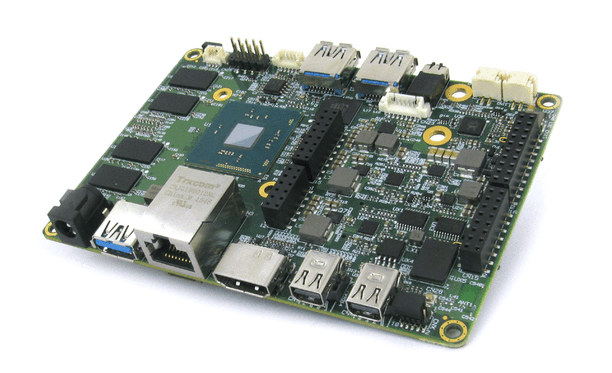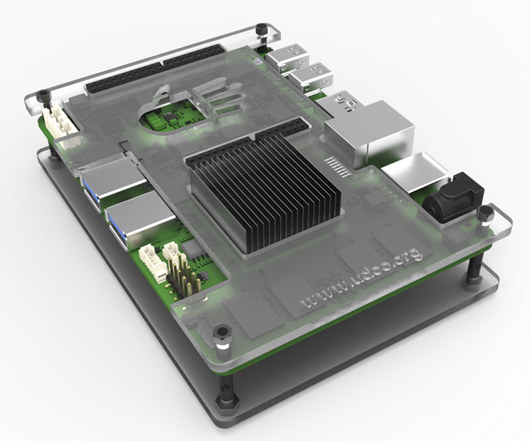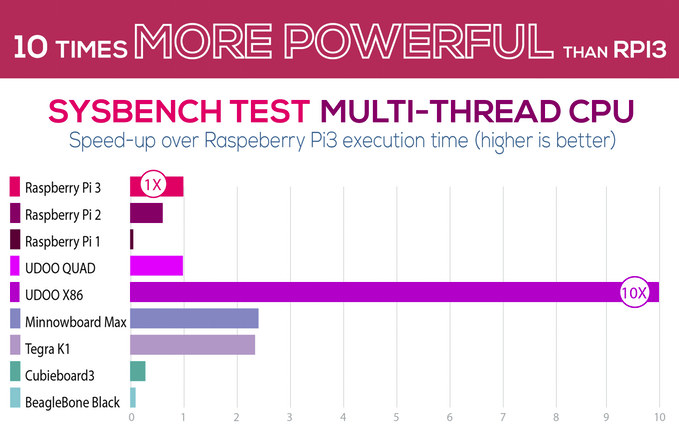UDOO is known for their ARM based development board with an MCU to control I/Os from Arduino compatible headers such as UDOO Quad or UDOO NEO. The community has now launched a new board called UDOO x86 powered by a quad core Intel processor, and integrating the Intel Curie compute module with Quark SE MCU used in Arduino 101, and the Arduino UNO headers. The basic version will come with Atom x5-E8000 Cherry Trail Braswell processor while the advanced version will feature Celeron N3160 Braswell processor.
 UDOO x86 Basic and Advanced specifications:
UDOO x86 Basic and Advanced specifications:
- SoC
- Basic – Intel Atom x5-E8000 quad core processor @ 1.04 / 2.0 GHz GHz with 12EU Intel HD graphics @ 320 MHz (5W TDP)
- Advanced – Intel Celeron N3160 quad-core processor @ 1.6 GHz / 2.24 GHz (Turbo) with 12EU Intel HD graphics@ 320 MHz/640Mhz (4W SDP / 6W TDP)
- System Memory
- Basic – 2 GB DDR3L
- Advanced – 4GB DDR3L
- Storage – 8GB eMMC, SATA connector, M.2 SATA slot, and micro SD card slot
- Video Output – 1x HDMI port with CEC support, 2x mini DisplayPort++ (Dual-mode DisplayPort)
- Audio I/O – HDMI, mini DP, microphone and headphone combo connector, speaker header, and S/PDIF output
- Video Codec
- Decode – H.265/HEVC, H.264, MPEG-2, MVC, VC-1, WMV9, VP8
- Encode – H.264, MVC, JPEG
- Connectivity – Gigabit Ethernet, optional 802.11ac WiFi and Bluetooth 4.0 using M.2 slot
- USB – 3x USB 3.0 host ports
- Serial – 2x UART ports on interrupt pin headers
- Headers (for quad core processor) – Up to 20 external GPIOs, LPC, 2x I2C, GPIOs, touch screen I/F
- Arduino part:
- Intel Curie module with Intel Quark SE @ 32 MHz and 32-bit ARC core @ 32 MHz
- SPI flash
- Bluetooth LE
- 6-axis accelerometer and gyroscope
- Arduino UNO headers (3.3V I/Os with protection against 5V over-voltage):
- 14 digital I/Os including 4 PWM
- 6x 10-bit analog inputs
- Misc – IR receiver
- Power Supply – 12V/3A
- Dimensions – 12 x 8.5 cm

The board can run Android, Linux, and Windows, and support up to three 4K displays simultaneously. Bear in mind, that HDMI (and DisplayPort?) audio will most likely not work in UDOO x86 Basic, but should be OK in UDOO x86 Advanced (Finally both are Braswell part so HDMI audio could be working on both). You can program the Arduino part using Arduino 101 IDE running on the Intel part of the board just like you’d if you had a computer and a separate Arduino 101 board, except you’d known need to connect both since they are already connected via a USB interface.
The 8GB internal storage only won’t do it to run Windows 10, but you’ll also be able to boot from USB 3.0, Ethernet, M.2 SATA or a micro SD card. The schematics (PDF), 3D design files, and the Bill of Material (BOM) will released under a Creative Commons CC BY-SA 3.0 license at the end of the campaign, as they’ve done previously with other UDOO boards.

Pricing is also pretty good as UDOO x86 Basic is listed on Kickstarter for $89 (early bird), and UDOO x86 Advanced for $109 (early bird), after which the price will go up to respectively $109 and $129. However, the power supply, and various cables are not included, so you may want to check the kit instead ranging from UDOO x86 Basic starter kit ($114) with the board, a 12V/3A power adapter, an HDMI cable, SATA + Power cables, and the acrylic enclosure, to UDOO x86 Advanced performance kit ($169) with the board, a 32GB SATA III M.2 SSD, 802.11ac WiFi + Bluetooth module, the power adapter, an HDMI cable, SATA + Power cables, and an acrylic enclosure. Shipping adds $18 to anywhere in the world, and delivery is scheduled for November 2016.

Jean-Luc started CNX Software in 2010 as a part-time endeavor, before quitting his job as a software engineering manager, and starting to write daily news, and reviews full time later in 2011.
Support CNX Software! Donate via cryptocurrencies, become a Patron on Patreon, or purchase goods on Amazon or Aliexpress




